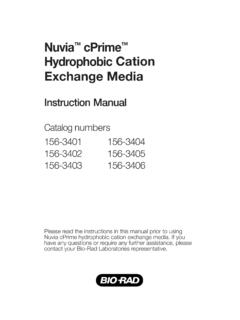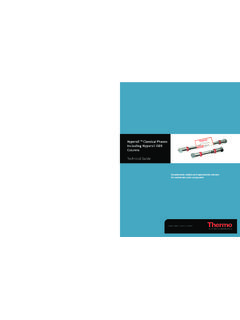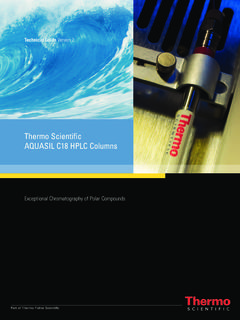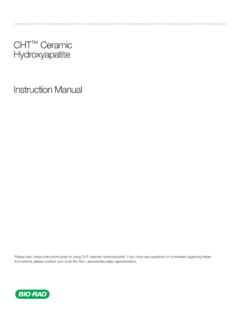Transcription of General HPLC Column Care - The Nest Group
1 General hplc Column CareThe correct use of an hplc Column is extremely important for the life time of a Column andtherefore for the benefit of your hplc analysis. The following pages will give you someguidelines for the use, cleaning and storage of hplc columns . These guidelines depend onthe one hand on the nature of the chromatographic support (silica, polymers or others) and onthe other hand on the surface chemistry of the corresponding stationary based columnsGeneral guidelinesSilica is the ideal support for hplc columns . It offers a large mechanical stability, excellentphysicochemical surface properties, a wide range of bonding chemistries and is compatiblewith a broad range of organic solvents. However, the following points are extremelyimportant to know when working with silica based hplc columns . pH stabilityIn General , hplc columns are stable within a pH range of 2 to 8.
2 If you are measuring apH value, the measurement must be done in the aqueous media before mixing the eluentwith organic solvents. Modern hplc columns can be used outside that pH range. Thenew bonding chemistries allow use down to pH 1 for some stationary phases. However,please check vendor s product information before using silica based Column outside thepH range of 2 to 8. However, best lifetimes are obtained between pH and pH phases based on ultra pure silica gel can also be used at higher pH ranges, upto pH 11, depending on the chemical nature of the modifier used in the mobile bases (like Pyrolidine) are not able to attack the surface of the silica and thereforecan be used at higher pH values. If you are working at pH values above 8 with smallbases as modifier (like Ammonia), we highly recommend using stationary phases basedon Polymers or Zirconiadioxide.
3 Mechanical stabilityStationary phases based on silica are mechanically very stable. The packed columnsshow no pressure limit and can be used at more than 40 MPa (6000 psi) without anyproblem. However, please avoid pressure shocks on the Column . Pressure shocks lead tochanneling in the Column , which results in peak splitting in the correspondingchromatogram. Mobile phases (Eluents)Silica based stationary phases are compatible with all organic solvents in the abovementioned pH range. Please use the highest quality solvents available ( hplc grade).Also, please filter all prepared buffer through a m filter before using them in yourHPLC system. Always keep in mind; your Column is the best filter!The use of non pure solvents in hplc causes irreversible adsorption of impurities on thecolumn head. These impurities block adsorption sites, change the selectivity of thecolumn and lead to peak splitting in the chromatogram.
4 In gradient elution, impuritiescause so called Ghost Peaks . Ghost peaks are peaks that always appear in the sameposition on the chromatogram. Their origin is not the sample, but the impurities from thesolvents or solvent additives. Therefore, it is highly recommended to run a gradientwithout injection in the beginning of each method to determine the ghost avoid irreversible adsorption at the Column head, you should always use a use of a pre- Column increases the life time of a Column dramatically. In addition, apre- Column can filter solid parts stemming from pump seals or injection rotors. Analternative to a pre- Column is an in-line filter. These filters are attached directly to thecolumn. These filters get rid of solid parts in the eluent but will not avoid irreversibleadsorption of organic storage of hplc columns For short term storage, over night, columns can be stored in the eluent used in lastanalysis.
5 For middle term storage, 2 days or over the weekend, columns should be flushedwith pure water to prevent microbial growth. For long term storage, silica based columns should be stored in an aprotic water content should not be higher than 50%. The best storing solvent isAcetonitrile. Caution!!! Please make sure that all buffers are washed out of the Column beforeflushing with Acetonitrile. Buffer salts are mainly not soluble in Acetonitrile and canblock the capillaries and the timeThe equilibration time of a Column depends on the Column dimensions. In General , a columnis equilibrated after flushing with 20 Column volumes. The equilibration time for the mostimportant Column dimensions is summarized in the following dimensionColumn volume [ml]*Flow rate [ml/min]Equilibration time[min]250 x mm2,911,0058150 x mm1,741,0035100 x mm1,161,002350 x mm0,581,0012250 x mm2,201,0044125 x mm1,101,0022250 x mm0,550,2544150 x mm0,330,252650 x mm0,110,259*_T = 0,7 Shorter equilibration times are possible if you simply increase the flow rate.
6 It is no problemto do that if no chromatography is done. However, 20 Column volumes are necessary toensure a 100% of a columnIrreversible adsorption of impurities stemming from the matrix on the Column head can causechanges in selectivity or peak splitting. Often those dirty columns can be regenerated byapplying the following of RP packingsRP- packings are C18, C8, C4, C1, C30, CN or Phenyl stationary phases. Flush the Column with 20 Column volumes Water Flush the Column with 20 Column volumes Acetonitrile Flush the Column with 5 Column volumes Isopropanol Flush the Column with 20 Column volumes Heptane Flush the Column with 5 Column volumes Isopropanol Flush the Column with 20 Column volumes AcetonitrileRegeneration of NP (Normal Phase) packingsNP-packings are Silica, Diol, Nitro and Amino stationary phases. Flush the Column with 20 Column volumes Heptane Flush the Column with 5 Column volumes Isopropanol Flush the Column with 20 Column volumes Acetonitrile Flush the Column with 20 Column volumes Water Flush the Column with 20 Column volumes Acetonitrile Flush the Column with 5 Column volumes Isopropanol Flush the Column with 20 Column volumes HeptaneRegeneration of Ion Exchange PackingsIon exchange packings are Anion or Cation exchangers (WCX, SCX, WAX and SAX) Flush the Column with 20 Column volumes of the same eluent, but double the bufferconcentration Follow the regeneration protocol for RP packings (see above) Flush with 20 Column volumes of Water Equilibrate the Column now to the original based columnsPolymer based stationary phases show higher pH stability but lower mechanical stability,compared to silica based columns .
7 Also, polymer based packings are not compatible with allorganic solvents. They swell or shrink in some organic solvents. Unfortunately, the pressurestability and solvent compatibility are different for the different nature of polymers and frommanufacturer to manufacturer. Therefore, no General rules for the Column care of polymerbased materials can be given. Always read the instructions for the use of those columns . Incase of doubt please contact the corresponding manufacturer.






